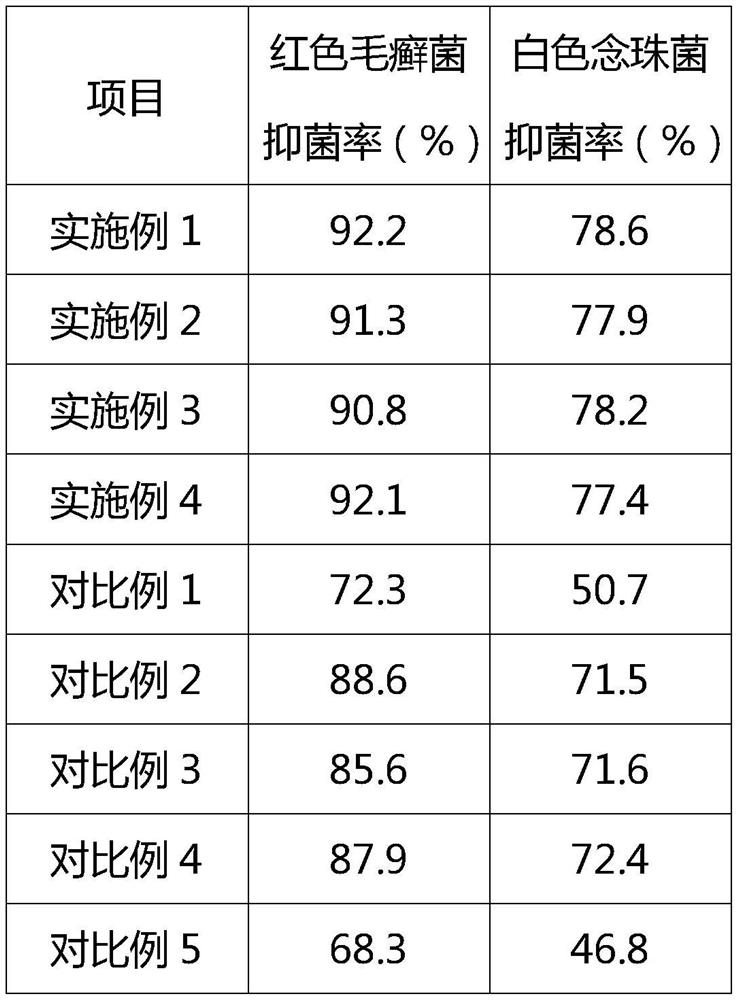A kind of preparation method of antibacterial deodorant thermoplastic rubber shoe material
A thermoplastic rubber and shoe material technology, applied in footwear, clothing, applications, etc., can solve the problems of poor folding resistance, antibacterial and deodorant properties, poor flexibility, etc., to achieve good aging resistance, good hand feel, good softness The effect of hardness
- Summary
- Abstract
- Description
- Claims
- Application Information
AI Technical Summary
Problems solved by technology
Method used
Image
Examples
preparation example Construction
[0027] The preparation method of the antibacterial particles is as follows: add terbinafine hydrochloride to the gum arabic solution, mix evenly, and then add a chitosan solution with a concentration of 1-5%, terbinafine hydrochloride, chitosan and arabic The dosage ratio of the gel solution is (0.5-0.8): (1-2): (5-10), stirred in a constant temperature water bath at 40°C for 10-20min to obtain a gel solution; distilled water was added to the gel solution to dilute, and the resulting The volume ratio of the gel solution and distilled water is 1:1, stir evenly; add sodium hydroxide to the solution and stir evenly, adjust the pH value of the solution to 4-5, and make the solution undergo complex coagulation reaction; reduce the reaction temperature to 0-5°C, then add glutaraldehyde for cross-linking and solidification to obtain a solidified solution, stir and react at a speed of 300-500r / min for 25-35min, then suction filter, wash, and freeze-dry to obtain a particle size of 8-10...
Embodiment 1
[0034] An antibacterial and deodorant thermoplastic rubber shoe material, the antibacterial and deodorant thermoplastic rubber shoe material includes the following raw materials in parts by weight: 20 parts of polyoxymethylene resin, 12 parts of neoprene rubber, 6 parts of polyester modified silicone resin, benzene 15 parts of ethylene-butadiene copolymer rubber, 13 parts of epichlorohydrin rubber, 8 parts of ethyl cellulose, 6 parts of macrogol glyceride laurate, 9 parts of styrene thermoplastic elastomer, 0.3 parts of antibacterial particles, nano silver 0.6 parts, 0.4 parts of antioxidant, 0.8 parts of dispersant;
[0035] The preparation method of the antibacterial microparticles is as follows: adding terbinafine hydrochloride to the gum arabic solution, after mixing evenly, adding a chitosan solution with a concentration of 3%, terbinafine hydrochloride, chitosan and the gum arabic solution The dosage ratio is 0.6:1.2:7, stirred in a constant temperature water bath at 40°...
Embodiment 2
[0042] An antibacterial and deodorant thermoplastic rubber shoe material, the antibacterial and deodorant thermoplastic rubber shoe material includes the following raw materials in parts by weight: 20 parts of polyoxymethylene resin, 14 parts of neoprene rubber, 3 parts of polyester modified silicone resin, benzene 16 parts of ethylene-butadiene copolymer rubber, 8 parts of epichlorohydrin rubber, 10 parts of ethyl cellulose, 7 parts of macrogol glyceride laurate, 10 parts of styrene thermoplastic elastomer, 0.4 parts of antibacterial particles, nano silver 0.5 parts, 0.6 parts of antioxidant, 0.4 parts of dispersant;
[0043] The preparation method of the antibacterial particle is: add terbinafine hydrochloride to the gum arabic solution, after mixing evenly, then add the chitosan solution whose concentration is 5%, terbinafine hydrochloride, chitosan and gum arabic solution The dosage ratio is 0.7:1:10, stirred in a constant temperature water bath at 40°C for 10 minutes to o...
PUM
| Property | Measurement | Unit |
|---|---|---|
| particle diameter | aaaaa | aaaaa |
| tensile strength | aaaaa | aaaaa |
| particle diameter | aaaaa | aaaaa |
Abstract
Description
Claims
Application Information
 Login to View More
Login to View More - R&D
- Intellectual Property
- Life Sciences
- Materials
- Tech Scout
- Unparalleled Data Quality
- Higher Quality Content
- 60% Fewer Hallucinations
Browse by: Latest US Patents, China's latest patents, Technical Efficacy Thesaurus, Application Domain, Technology Topic, Popular Technical Reports.
© 2025 PatSnap. All rights reserved.Legal|Privacy policy|Modern Slavery Act Transparency Statement|Sitemap|About US| Contact US: help@patsnap.com

